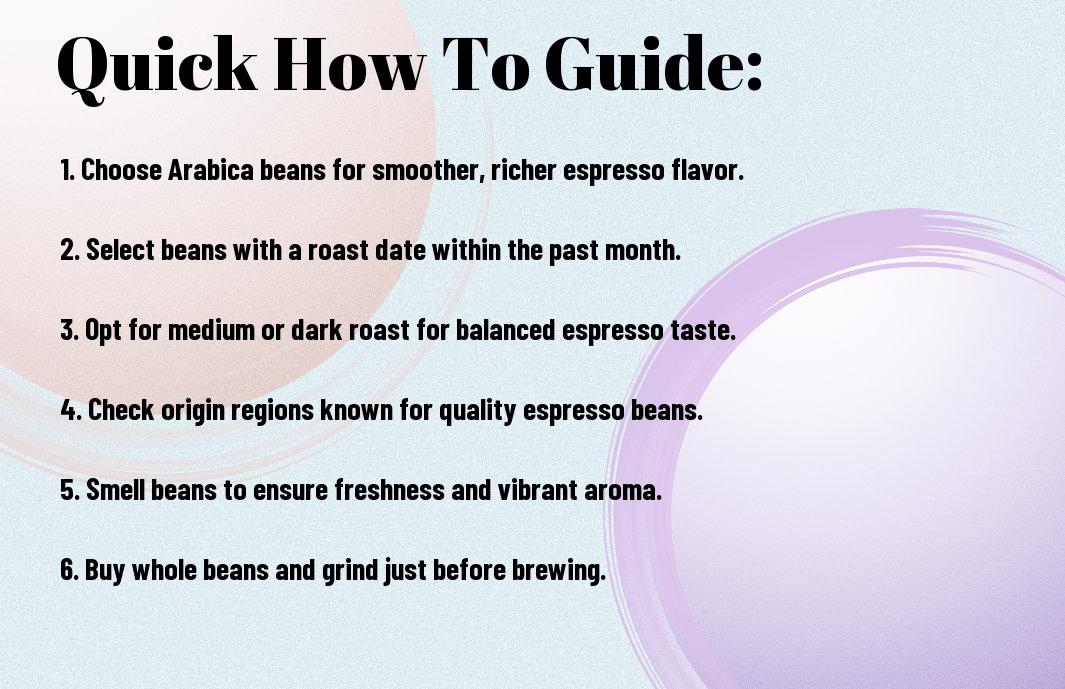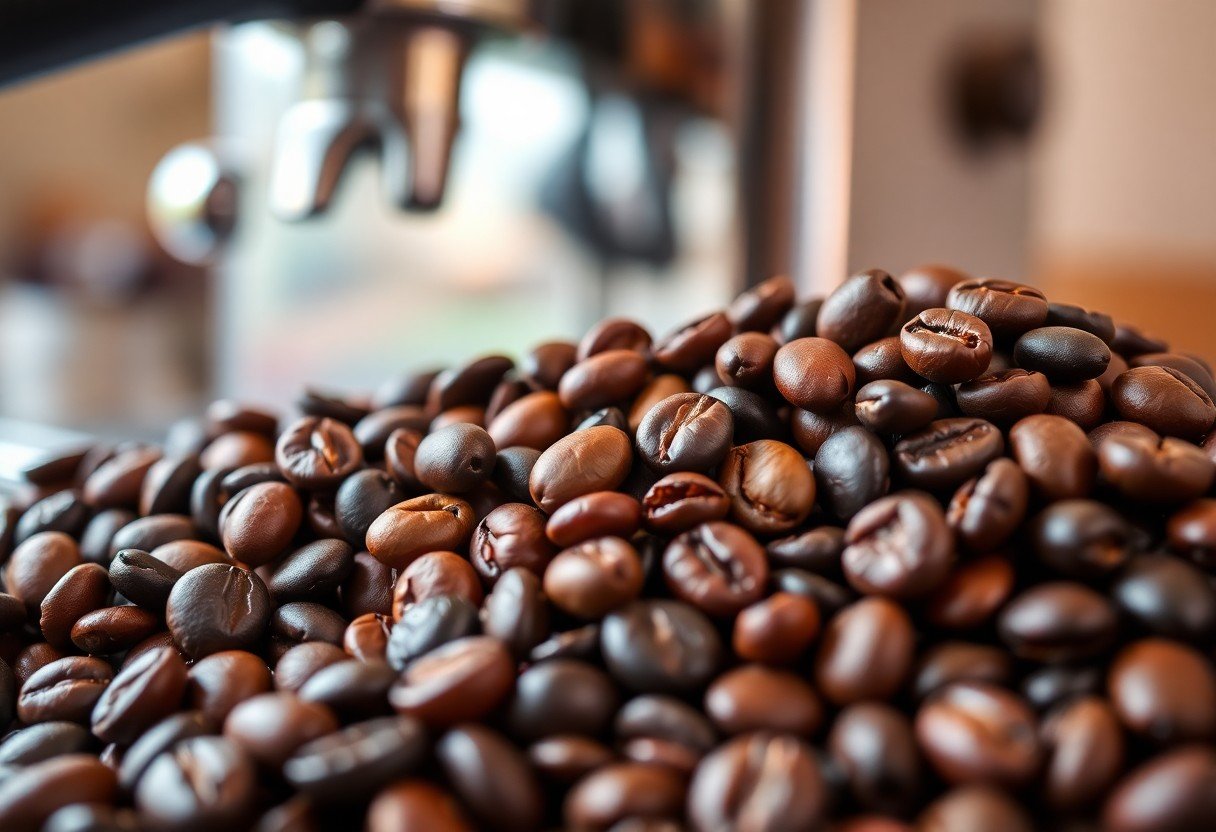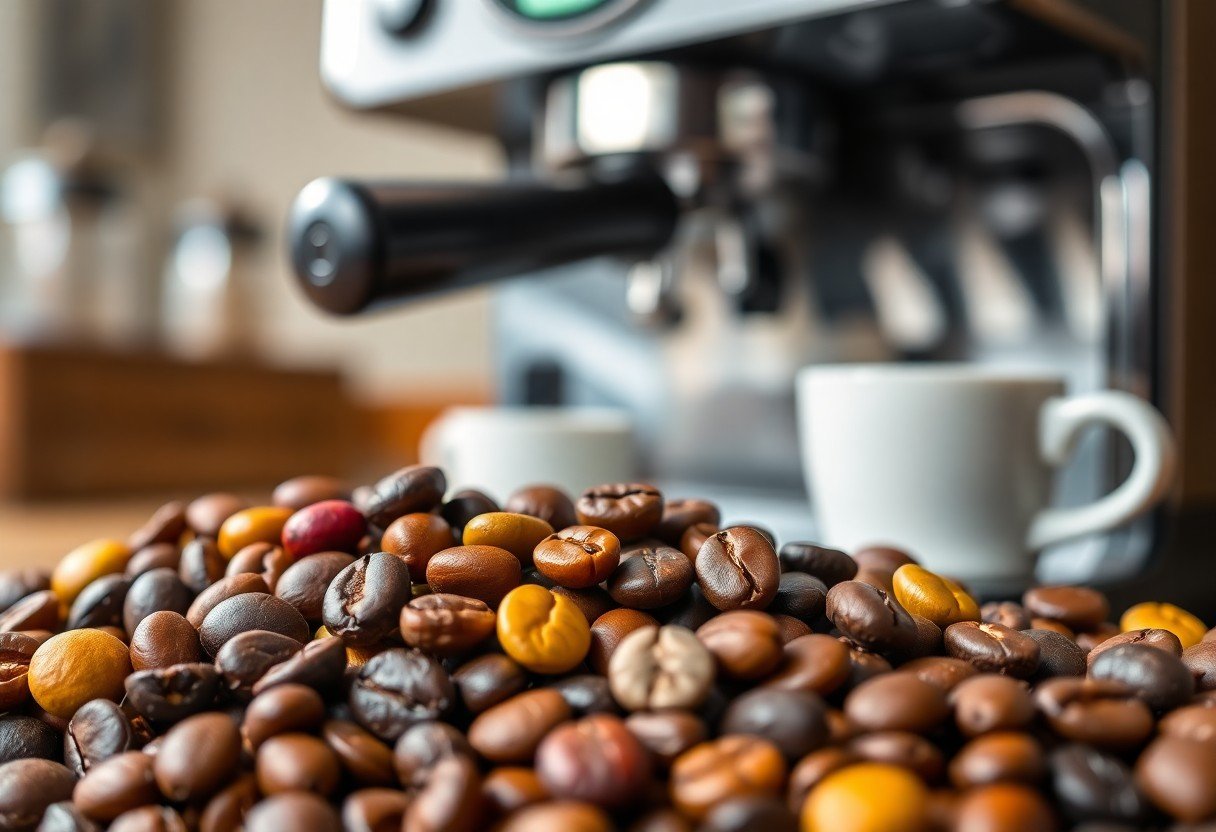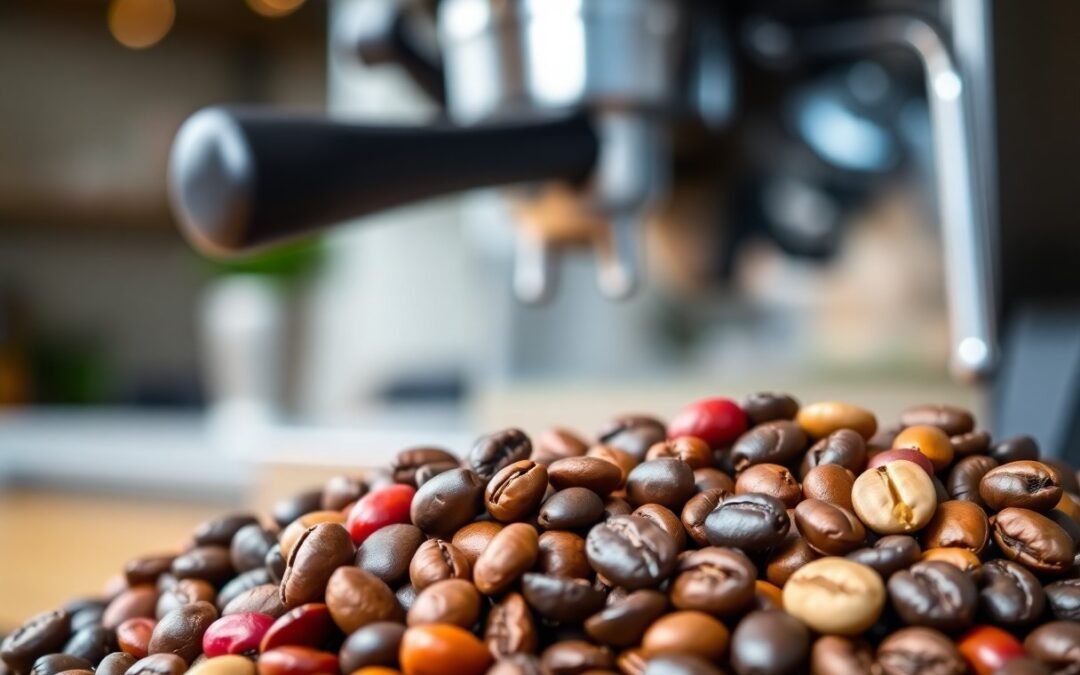Many coffee lovers aspire to brew the perfect espresso at home, but the journey begins with selecting the right coffee beans. In this crucial guide, you will learn how to identify the best beans that suit your taste and elevate your espresso experience. From exploring various coffee origins to understanding roast profiles, this guide will equip you with the knowledge you need to make informed decisions and create that rich, flavorful cup you’ve always desired.


The Quest for Flavor: Exploring Coffee Bean Varietals
Diving into the world of coffee varietals opens up a spectrum of flavors waiting to be explored. Each coffee bean comes with its own unique characteristics, influenced by factors such as origin, processing methods, and even the altitude at which they are grown. Understanding these varietals not only enhances your espresso experience but also allows you to tailor your pick to your personal taste preferences, whether you favor fruity notes, nutty undertones, or dark chocolate richness.
Arabica vs. Robusta: The Great Debate
The ongoing discussion between Arabica and Robusta sees coffee enthusiasts divided. Arabica beans, known for their sweet, complex flavors and higher acidity, generally yield an exceptional espresso with nuanced profiles. On the other hand, Robusta beans pack a punch with their earthy and bitter tastes, boasting higher caffeine content and a thicker crema, making them popular for espresso blends that require robustness and crema stability. Your choice between the two will mostly depend on the flavor profile you seek.
Lesser-Known Varietals Worth Trying
Exploring lesser-known coffee varietals can elevate your espresso experience to new heights, as they often showcase unique characteristics that mainstream beans may lack. Varietals like Geisha, Pacamara, and Bourbon present distinct flavor profiles that are often floral, fruity, or even reminiscent of candy. For instance, Geisha beans, originating from Ethiopia, are celebrated for their delicate jasmine and bergamot notes, making them a favorite among specialty coffee connoisseurs. Delve into these unique options to broaden your palate and discover flavors you didn’t even know existed.
Beyond the Bean: Understanding Coffee Processing Methods
Delving into coffee processing methods is necessary to fully appreciate the nuances of your espresso. Each technique affects the flavor, aroma, and body of the coffee beans, leading to unique tasting experiences. The methods generally include dry (natural) processing and wet (washed) processing, each bringing distinct qualities to the resulting brew. By understanding these processes, you can make informed choices that elevate your coffee enjoyment.
The Impact of Dry vs. Wet Processing
The choice between dry and wet processing significantly alters the final flavor profile of your espresso. Dry processing involves sun-drying whole coffee cherries, which produces fruitier flavors and fuller body, while wet processing removes the cherry’s outer fruit before fermentation, yielding cleaner and brighter taste characteristics. Understanding these differences can direct your bean selection toward your preferred flavor experience.
How Fermentation Influences Flavor Profiles
Fermentation, a key stage in coffee processing, profoundly impacts the flavor outcome of your espresso. During this process, sugars in the coffee cherry are broken down by microorganisms, resulting in unique taste notes. For instance, longer fermentation times often lead to more complex acidity and fruit-like sweetness, enhancing the overall flavor profile. Beans sourced from regions like Ethiopia that employ traditional fermentation methods can surprise you with their vibrant notes of berries and floral undertones.
Consider the role of fermentation in the final taste of your espresso; it’s a meticulous process governed by the type of yeast involved and the duration. For example, anaerobic fermentation, where oxygen is limited, can yield unexpected flavors reminiscent of wine or stone fruits. Contrastingly, a brief fermentation might give your coffee a crisp finish while showcasing its inherent bean characteristics. Factors such as climate and altitude also play a role in how beans develop during fermentation, ultimately leading to diverse and intriguing flavor profiles that can elevate your espresso experience.
The Role of Freshness: Why Date Matters More Than You Think
Choosing the right coffee beans involves more than just considering the origin or processing method; freshness plays a pivotal role too. Beans lose their flavor and aroma over time, impacting the quality of your espresso. To dive deeper into the imperative elements of selecting the perfect coffee for your brewing, check out How to Choose the Best Coffee Beans for Your Perfect Cup.
Roast Dates vs. Best By Dates
Roast dates are your best friend when it comes to ensuring flavor at its peak. Unlike best by dates, which may represent a generic timeframe, roast dates indicate precisely when the coffee was processed. Ideally, you want to consume coffee within a month of its roast date to fully enjoy the vibrant character and complexity it offers.
Optimal Storage Conditions for Maximum Freshness
To keep your coffee beans fresh, store them in an airtight container away from light, heat, and moisture. An opaque, vacuum-sealed container works wonders in maintaining quality. Avoid placing them in the fridge or freezer, as fluctuating temperatures can lead to condensation and spoilage.
For maximum freshness, a cool and dark pantry shelf is ideal. Temperature plays a substantial role; room temperature should be consistent and not exceed 70°F. Additionally, using small containers for daily use and keeping the bulk of your supply sealed will prevent exposure to air and light, preserving freshness and flavor over time.

Sourcing Quality: What to Look for in Bean Selection
Choosing the right coffee beans is a journey best approached with knowledge. Focus on origin, processing methods, and roast date to ensure quality. Regions like Ethiopia and Colombia are known for their unique flavor profiles. Pay attention to the processing method as well, with washed coffees often offering clarity while natural ones deliver fruity notes. Lastly, opt for freshly roasted beans, usually indicated by a roast date of no more than two weeks prior to your purchase, for a vibrant espresso experience.
Understanding Certifications and Ethical Sourcing
Certifications such as Fair Trade, Rainforest Alliance, and Organic ensure that coffee beans are sourced ethically and sustainably. These labels indicate responsible farming practices that respect both the environment and the rights of farmers. When you opt for certified beans, you support fair wages and eco-friendly cultivation methods, contributing to socio-economic improvement in coffee-growing regions. This not only enhances the quality of your brew but also aligns your coffee consumption with your personal values.
Local Roasters vs. Commercial Brands: Making The Right Choice
Selecting between local roasters and commercial brands can greatly influence your coffee experience. Local roasters, often more hands-on, tend to emphasize quality and unique flavor profiles that reflect their region. In contrast, commercial brands may prioritize consistency and broader distribution. Exploring local options can lead you to discover distinctive tastes that large producers might overlook, providing an intriguing espresso adventure tailored to your palate.
Choosing local roasters allows you to engage in the coffee community and learn about the sourcing and roasting processes directly from passionate artisans. Many local roasters prioritize small-batch roasting and variety in bean selection, allowing for fresher and more diverse flavors. You can attend cupping sessions or shop directly from them, fostering a close relationship with the source of your coffee. This often results in a fresher and livelier espresso compared to the sometimes overly uniform flavors of commercial brands. Exploring your local coffee scene not only supports small businesses but enriches your espresso experience with depth and character that mass-produced options may lack.
Brewing for Perfection: Adapting to Your Equipment
Achieving the perfect espresso involves more than just selecting high-quality beans; adjusting your brewing technique to your specific equipment is equally significant. Whether you’re using a manual espresso machine, a semi-automatic, or an automatic setup, each has its unique characteristics that affect the extraction process. Understanding how to calibrate your grind size, water temperature, and extraction time in accordance with your machine’s capabilities will help you unlock the full potential of your coffee beans and elevate your espresso game.
The Importance of Grind Size for Espresso
A proper grind size is vital for extracting the rich flavors and aromas in espresso. The ideal grind should be fine, resembling table salt, allowing water to flow through it at the appropriate rate for optimal extraction. If your grind is too coarse, the water will pass through too quickly, resulting in a weak and under-extracted shot. Conversely, a grind that’s too fine can lead to over-extraction, resulting in a bitter taste. Experimenting with various grind settings tailored to your espresso equipment will help you discover the perfect balance.
Water Quality and Temperature: The Unsung Heroes
Water is often overlooked, but its quality and temperature play vital roles in espresso preparation. Using filtered water free from impurities enhances the flavor profile of your coffee. Ideal brewing temperatures range from 195°F to 205°F (90°C to 96°C). Water that’s too hot can scald the coffee, while water that isn’t hot enough won’t extract the beans fully. Consistently utilizing quality water in the right temperature range contributes significantly to a balanced and flavorful espresso shot.
Water Quality and Temperature Overview
| Aspect | Importance |
|---|---|
| Water Quality | Influences taste and aroma; impurities can mask coffee’s true flavors. |
| Water Temperature | Affects extraction; ideal range is 195°F – 205°F for optimal flavor. |
Investing in a water filtration system can dramatically improve the purity of your brewing water, thus enhancing the espresso experience. Additionally, utilizing a thermometer or a quality espresso machine with precise temperature controls can help maintain consistent brewing temperatures, allowing you to achieve the ideal extraction every time. This attention to water quality and temperature ensures that your espresso captures the nuanced characteristics of the beans you’ve carefully selected, resulting in a truly exceptional cup.
Water Quality and Temperature Insights
| Factor | Effect on Espresso |
|---|---|
| Total Dissolved Solids (TDS) | Affects extraction rates and flavor balance; ideally between 75-250 ppm. |
| pH Level | Impacts flavor extraction; aim for a pH around 6.5 to 7.5 for best results. |
Conclusion
So, as you commence on your journey to find the best coffee beans for your perfect espresso experience, keep in mind the key factors like bean origin, roast profile, and freshness. By understanding your taste preferences and experimenting with different varieties, you’ll elevate your brewing skills and enjoy a rich, flavorful espresso. Trust your palate and take the time to explore, and soon, you’ll discover the beans that suit your unique style and ensure each cup is a delightful experience.
FAQ
Q: What characteristics should I look for when selecting coffee beans for espresso?
A: When choosing coffee beans for espresso, consider the following characteristics: flavor profile, roast level, and freshness. Look for beans labeled as espresso or those with tasting notes that include chocolate, caramel, or nuts, as these flavors often complement the espresso experience. A medium to dark roast level is typically preferred, as it brings out richer flavors suitable for espresso. Freshness is key, so aim for beans that were roasted within the last two weeks, and check for a roast date on the packaging.
Q: Are single-origin beans better for espresso than blends?
A: Whether single-origin beans or blends are better for espresso depends on personal preference. Single-origin beans offer distinct flavors that are unique to their growing region, providing a more refined and specific taste experience. However, blends are designed to create a harmonious flavor profile by combining various beans, often resulting in a balanced and complex espresso. Ultimately, exploring both options is a great way to discover which suits your palate best.
Q: How can I determine if the coffee beans I choose are of high quality?
A: To assess the quality of coffee beans, look for several indicators. Check the packaging for certification seals, such as organic, Fair Trade, or specialty grade, which often signify higher quality. Pay attention to the origin of the beans, as well-known coffee-producing countries around the world are often synonymous with quality. Additionally, inspecting the appearance of the beans is important; they should be uniform in color and free from defects. Lastly, sampling will be the ultimate test: brewing a cup will allow you to evaluate the flavor and aroma firsthand.

